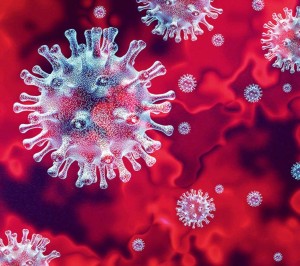Research activities in the areas of X-ray imaging and ultraviolet sterilization illustrate how photonics is helping to combat the threat of COVID-19.
As the COVID-19 pandemic caused by the SARS-CoV-2 coronavirus sweeps around the globe causing widespread misery and disruption, photonics researchers are considering how they can help. At the virtual IEEE International Symposium on Biomedical Imaging (ISBI 2020; http://2020.biomedicalimaging.org/) in early April, a special online session entitled ‘COVID-19, deep learning and biomedical imaging’ brought together a panel of six imaging experts from the US, Israel, the Netherlands and Denmark to discuss opportunities. The debate centred on how artificial intelligence (AI) could perhaps help by performing automated analysis and classification of chest X-rays and computer tomography (CT) scans from the lungs of patients with COVID-19, making it possible to identify the presence of the disease and assess its severity.

The idea and hope is that well-trained algorithms applied to lung images may provide an automated clinical means of diagnosis of COVID-19 that has a high degree of confidence and does not require any reagents, disposable consumables or lengthy processing times unlike swab polymerase chain reaction (PCR) tests. It is now known that the pneumonia associated with COVID-19 tends to present several typical signatures in lung images — in particular, so-called reverse halos, crazy-paving and ground glass features. Using AI to identify COVID-19 thus seems to be a realistic proposition.
“Chest radiographs cost under US$1 but their interpretation is difficult,” Eliot Siegel, chief of radiology at the University of Maryland School of Medicine in the US told attendees. “Can we use AI to distinguish COVID-19 from other respiratory diseases? Can we quantify the disease? Can we distinguish between acute and mild versions and track its trajectory?”
Bram van Ginneken from the diagnostic image analysis group at Radboud University in the Netherlands described efforts in the country to collect and analyse CT images of patients with COVID-19, yielding a standardized classification and diagnosis scheme called CORADS that has a score of one to six, with four and above indicating a high level of suspicion of COVID-19 infection (https://radiologyassistant.nl/chest/covid-19-corads-classification).
“There’s an enormous shortage of PCR swab tests, you have to wait for results and if the infection has moved from the nose and throat to the lungs it may not be detected by swab tests,” said van Ginneken. “Eight radiologists in seven Dutch hospitals have been assessing COVID-19 cases and we’ve found that the CORADS clinical diagnosis and the PCR test agree well.”
Furthermore, researchers say that AI may also be able to judge the severity of the disease, providing a quantitative score or metric that ranks the patient’s condition and prognosis, opening the way for new forms of triage and screening at hospitals.
Hayit Greenspan from Tel-Aviv University described efforts to develop a ‘Corona-Score’ that provides a quantitative metric for patients with COVID-19 by determining the volume of opacities in their lungs by applying algorithms to a three-dimensional fusion of image slices. “The Corona-Score represents the extent of the disease and strongly correlates to the severity of the disease,” explained Greenspan.
In a similar vein, in the US, Raul San Jose Estepar from Harvard University described the team’s development of an app called Covictory (details at https://acil-bwh.github.io/slowdown-covid19/). The idea is that a smartphone is used to take a photo of a portable chest X-ray image and the app uses AI algorithms to determine if the image likely represents normal healthy condition or mild or moderate/severe COVID-19, providing percentages for each situation. The thinking is that such a system may be a useful additional screening tool.
Moving away from the discussion at ISBI, scientists and tech firms are exploring the opportunities for ultraviolet (UV) sterilization as a convenient means for eradicating coronavirus from pieces of personal protective equipment (PPE) and contaminated surfaces. It’s well established that short-wavelength UV-C light (200–280 nm region) is highly effective at killing bacteria and viruses by damaging their genetic material (DNA or RNA) if the dose of the light is sufficient, thus providing an environmentally friendly, chemical-free means for sterilization.
With this in mind, Andrea Armani’s group from the University of Southern California has developed a simple UV-C chamber for sterilizing face visors. The system consists of 18-gallon plastic bins that are internally coated with highly reflective chrome paint and equipped with 15-W high-intensity UV-C bulbs. Armani says that a chamber costs just US$50, can hold 3 face shields at once, and it takes 6 minutes to perform a sterilization cycle. By working with a local firm in Los Angeles, 50 systems have been manufactured and donated to local hospitals in the region. So far, the team has focused on sterilization of face shields as this is straightforward and works well, and Armani says that other pieces of equipment such as N95 masks, “could be tricky” due to their more complex composition. Interestingly, the Danish firm UVD Robots has taken things a stage further and has equipped autonomous robots with UV light sources in order to perform automated sterilization of spaces. It takes about 10–20 minutes for its disinfection robot to treat a room, according to the firm.
It is likely that the valuable contributions from vaccine hunters, epidemiologists and virologists will be best remembered for how science ultimately triumphed over COVID-19, but it’s possible that photonics may play a small role along the way.
Rights and permissions
About this article
Cite this article
Shining a light on COVID-19. Nat. Photonics 14, 337 (2020). https://doi.org/10.1038/s41566-020-0650-9
Published:
Issue Date:
DOI: https://doi.org/10.1038/s41566-020-0650-9
This article is cited by
-
Multi-responsive deep-ultraviolet emission in praseodymium-doped phosphors for microbial sterilization
Science China Materials (2022)
-
XCOVNet: Chest X-ray Image Classification for COVID-19 Early Detection Using Convolutional Neural Networks
New Generation Computing (2021)
